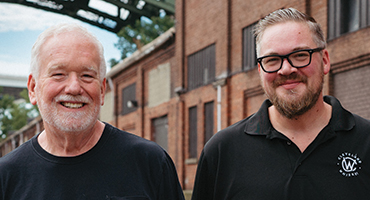After more than a decade on East 25th Street, Cleveland Whiskey is moving across town into a century-old riverfront building. Though only a few miles away, the new location will provide nearly 10 times more space for the company’s proprietary whiskey-finishing process, with capacity to increase production more than 24-fold over the next two years.
CEO Tom Lix, who founded the company in 2009, says the operation outgrew its original home in the MAGNET building long ago, leaving it “capacity constrained” and lagging behind orders for its award-winning spirits. To keep up with increasing production demands and tap into advanced innovations, Cleveland Whiskey needed more space.
Lix found a new home for his distillery-disrupting business in an abandoned brick warehouse tucked between a decommissioned street and a defunct railway underneath the Hope-Memorial Bridge. With plenty of space to accommodate production, plus tours, tasting events and eventually a restaurant, Lix saw potential amid the awesome views of ships cruising through the canal.
But transforming the neglected space into a spirited destination has been a challenge nearly four years and $8 million in the making. Understandably, Lix is eager to open the doors.
Rehab before revival
The first phase of Cleveland Whiskey’s riverfront revival focused on making the building operational. Built in 1911 to house the Consolidated Fruit Auction Company, the historic facility’s narrow design was innovative for its time, Lix explains. Stretching 400 feet long but less than 50 feet wide, the building was designed so railcars could quickly unload produce on one side, while horse-drawn wagons (and eventually trucks) loaded up on the other side.
But after sitting empty for about 15 years, the building at 601 Stones Levee desperately needed rehab. Extensive renovations included miles of new electrical wire, updated plumbing, heating and safety systems, and plenty of repaired walls and replaced windows along the way.
“It would’ve been cheaper to tear it down and put up a new building,” says Lix, who has already invested about $8.5 million into an expected $20 million renovation. “But I love that we’re bringing this old building back to life. It’s full of character.”
Innovative spirits
Lix took advantage of the building’s long, narrow shape to lay out the production line with an efficient, linear flow.
The process starts in the back of the building, where milled grain will enter on a conveyor. Previously, Cleveland Whiskey sourced premilled grain, but the addition of an onsite mill will enable Lix to experiment with other raw ingredients and “buy local from smaller farmers who can’t mill their own grains,” he says.
Milled grain will be conveyed into large stainless steel fermentation tanks, and then eventually fed into stills. To be classified as whiskey, this distillate must be aged in oak barrels. Traditional whiskeys derive their entire flavor profile from this part of the process, as spirits age in barrels for several years.
Shirking this tradition, Lix invented a proprietary method of finishing young spirits in “pressure-capable stainless steel tanks, or reactors.” After aging in barrels for six to 12 months, spirits move into these reactors, along with chunks of wood that have been cut to certain dimensions using a patented machine. Inside the tanks, pressure and temperature variations accelerate the chemical reactions that produce the flavors of aged whiskey — in just 24 hours. This innovative process enables Lix to experiment with woods like black cherry, hickory, honey locust and sugar maple.
“That’s something nobody else can do,” he says. Traditional whiskeys age in oak because it makes the most durable barrel. “But if you made a barrel out of black cherrywood, it would leak like a sieve. And if you put black cherrywood staves inside an oak barrel, the oak would dominate the flavor,” Lix says. “Other types of whiskey all have the same DNA because they’re done in oak barrels, whereas ours is an entirely different family because we can introduce new DNA.”
Capacity for growth
Cleveland Whiskey’s production process ends at the bottling line, which is now powered by a new machine that automatically washes, fills, seals and labels 12 bottles at once. By comparison, the small bottling machine at the original location could only process four bottles at a time, manually.
At the previous facility, Cleveland Whiskey processed about 60 gallons of spirits each day in its patented finishing system.
“Once we move, our production goes to 240 gallons per day — four times the capacity,” Lix says. “We also have the utilities infrastructure in place to take that to 1,440 gallons per day as we build out the systems over the next 12 to 24 months.”
Increased production capacity isn’t the only advantage of this move, Lix says; it’s also “an opportunity to bring more people in.” Lix hopes to open soon so he can welcome guests to tour the facility and taste the difference of whiskey made beyond the limits of tradition — a difference confirmed by 115 awards and 54 percent of blind taste tests. “People who taste it generally like it,” he says. “If we can get people coming here, it’s going to be great for us.”

